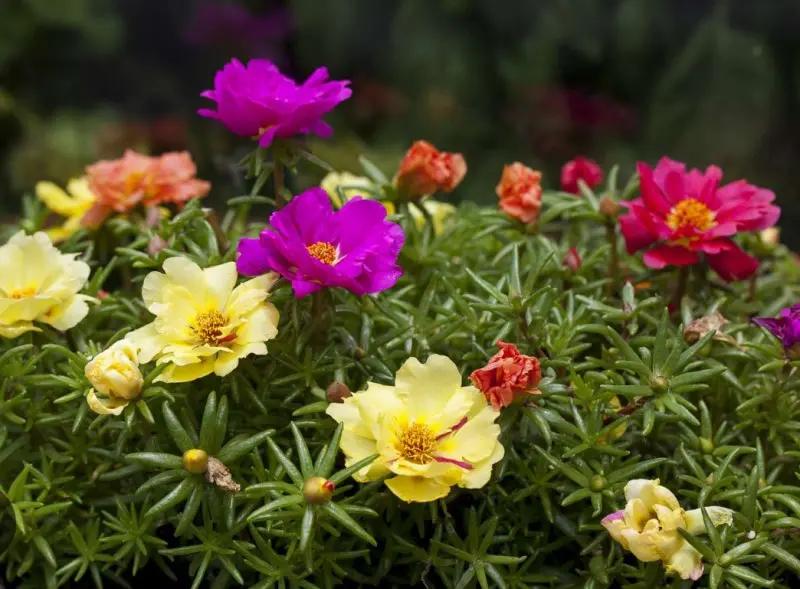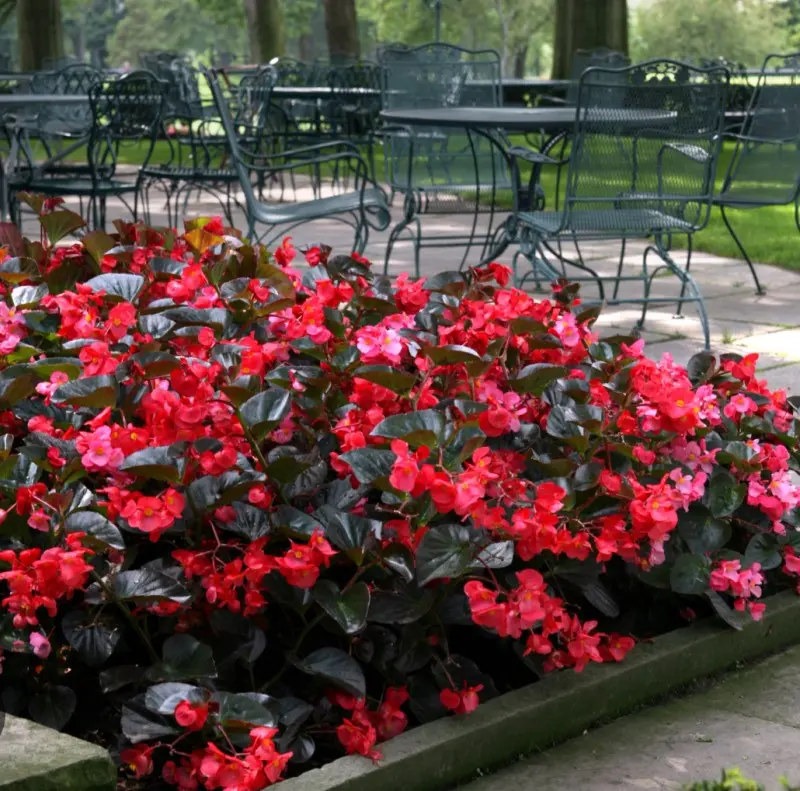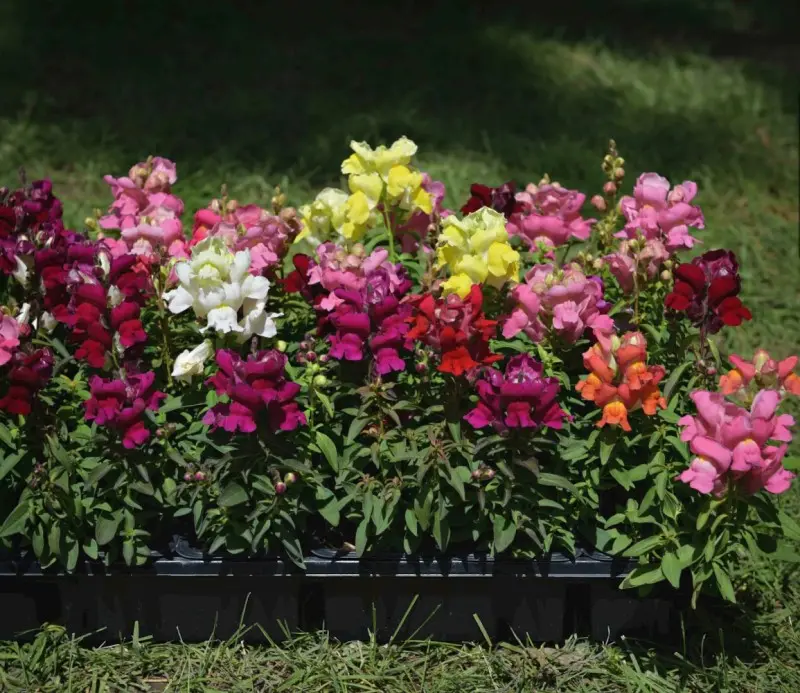-

Portulacas
$0.00
Spring
4 to 8 inches tall
Deer Resistant
-
Portulacas (Portulaca grandiflora), also known as Moss Rose or Sun Rose, are low-growing, heat-tolerant annuals prized for their vibrant, rose-like blooms and succulent foliage. Native to South America, these tough, drought-resistant plants produce a continuous display of bright flowers in shades of pink, yellow, red, orange, and white throughout the summer. The blooms open fully in bright sunlight and close at night, giving a cheerful, sunny appearance to garden beds, rock gardens, and containers.
Portulacas typically grow 4 to 8 inches tall with a spread of 12 to 18 inches, forming a dense, carpet-like mat that makes them ideal as a ground cover or filler in garden beds and between pavers. They thrive in USDA zones 10-11 as perennials but are grown as annuals in cooler climates. Portulacas prefer full sun and perform best in well-draining, sandy, or rocky soil, making them an excellent choice for xeriscape gardens or areas with poor soil. Once established, they are highly drought-tolerant and require little to no watering, making them low-maintenance for hot, dry landscapes.
Portulacas are generally pest-resistant and require little care beyond occasional deadheading to encourage more blooms, although many varieties are self-cleaning. They benefit from minimal fertilizer, as too much can reduce flower production. With their vibrant colors, resilience in hot weather, and low-water needs, Portulacas are a perfect choice for gardeners looking to add long-lasting color and ground cover in sunny, dry areas where many other plants may struggle.
-

Coleus
$0.00
Summer
12 to 36 inches tall
Not Deer Resistant
-
Coleus (Solenostemon scutellarioides), also known as Painted Nettle, is a vibrant, shade-loving plant prized for its colorful, intricate foliage. Native to Southeast Asia and parts of Africa, Coleus is grown primarily for its striking leaves, which come in a wide array of colors, including shades of red, purple, yellow, green, pink, and orange. The leaves often have unique patterns, including stripes, blotches, and veins, creating a dynamic, eye-catching display in garden beds, containers, and as indoor plants. Known for adding a pop of color to shaded areas, Coleus offers season-long interest from spring through fall.
Coleus plants range from 6 inches to 3 feet in height and can vary in growth habit, from compact, bushy forms to trailing varieties ideal for hanging baskets. They thrive in partial to full shade but can also tolerate some morning sun, particularly in cooler climates. Preferring well-draining, moist soil rich in organic matter, Coleus plants require regular watering, especially in hot weather, to keep their foliage vibrant and lush. Although they are typically grown as annuals in cooler climates, Coleus can be grown as a perennial in USDA zones 10-11, where frost is not a concern.
Low-maintenance and easy to grow, Coleus benefits from regular pinching to encourage bushier growth and prevent flowering, as the flowers can draw energy away from the foliage. It is generally pest-resistant, though it may attract aphids or whiteflies in very humid conditions. With its wide range of colors, intricate leaf patterns, and adaptability to both outdoor and indoor environments, Coleus brings vivid, season-long color and texture to gardens, patios, and indoor spaces. Its versatility and ease of care make it a favorite for gardeners looking to brighten up shaded areas with little effort.
-

Dianthus
$0.00
Spring/Summer/Fall/Winter
6 to 12 inches tall
Deer Resistant
-
Dianthus (Dianthus spp.), commonly known as Pinks or Carnations, is a charming flowering plant admired for its delicate, fringed petals and sweet, clove-like fragrance. Native to Europe and Asia, Dianthus comes in a range of colors, including shades of pink, red, white, purple, and bicolors. Known for its star-shaped, often ruffled blooms, Dianthus is a popular choice for garden borders, rock gardens, and containers, adding color and scent from late spring through fall.
Dianthus plants typically grow from 6 inches to 18 inches in height, depending on the variety, and feature narrow, bluish-green foliage that provides a soft, textural contrast to the flowers. These plants thrive in full sun and well-draining, alkaline soil enriched with organic matter. Although Dianthus is moderately drought-tolerant once established, it benefits from regular watering to maintain blooms, particularly during dry periods. Hardy in USDA zones 3-9, many Dianthus varieties are perennial, allowing them to return year after year, while others are grown as biennials or annuals in cooler climates.
Easy to care for, Dianthus requires minimal maintenance beyond occasional deadheading, which promotes additional blooming and prevents the plant from becoming leggy. It is generally resistant to pests and diseases but may attract occasional aphids or slugs in wet conditions. With its delightful fragrance, long-lasting blooms, and compact form, Dianthus is a versatile plant that enhances gardens with color, scent, and texture, making it a popular choice for gardeners seeking low-maintenance beauty in borders, beds, and containers.
-

Begonias
$0.00
Spring
6 to 18 inches tall
Not Deer Resistant
-
Begonias (Begonia spp.) are beloved flowering plants known for their vibrant, long-lasting blooms and lush, decorative foliage. These versatile plants come in an impressive variety of colors, shapes, and sizes, making them ideal for adding color and texture to gardens, borders, containers, and indoor spaces. With blooms in shades of pink, red, white, orange, and yellow, begonias are known for their season-long flowering from spring through fall, particularly when grown in shaded to partially shaded areas. Their ability to thrive in lower light conditions makes begonias popular for brightening up shaded corners and covered areas.
Begonias are available in several types, each with unique qualities suited to different planting environments. Wax Begonias (Begonia semperflorens) are compact plants with rounded, waxy leaves, making them ideal for garden beds and borders. Tuberous Begonias (Begonia tuberhybrida) feature large, showy blooms in bright colors and work wonderfully in hanging baskets or containers. Rex Begonias (Begonia rex-cultorum) are primarily grown for their striking, variegated foliage and are popular both as houseplants and in shaded gardens. These varieties allow gardeners to choose begonias that fit specific aesthetic and functional needs within their landscaping designs.
To thrive, begonias prefer well-draining, slightly acidic soil enriched with organic matter, as well as partial to full shade to protect them from intense sun, which can scorch their leaves. These low-maintenance plants benefit from regular watering, ideally keeping the soil moist without becoming waterlogged, as well as periodic deadheading to encourage more blooms and maintain a compact shape. Although begonias are generally pest-resistant, they may attract snails and slugs in damp conditions. With their colorful flowers, attractive foliage, and adaptability to both indoor and outdoor environments, begonias are a favorite choice for bringing elegance and season-long color to shaded gardens, patios, and home interiors.






